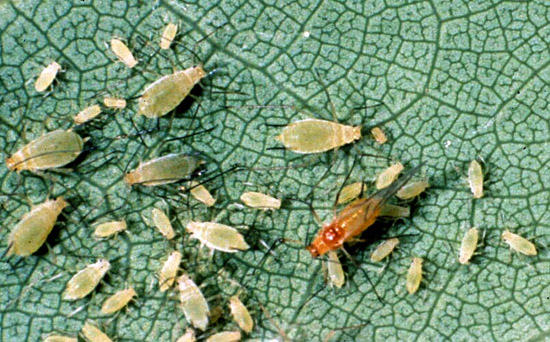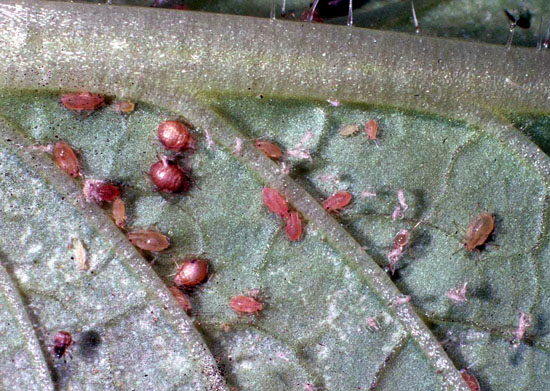Issue 5, May 21, 2010
Aphids
High populations of aphids have been reported in northeastern Illinois. With warmer, drier weather in the forecast, other areas of the state may see high populations as well in the next couple weeks.
Aphids are small, soft-bodied, pear-shaped, sucking insects. Although many species are green, there are aphid species in many other colors as well. Most species range from pinhead-sized to one-eighth inch in length, although giant bark aphids are about one-quarter inch long. Aphids feed by tapping phloem vessels, removing large quantities of sap. Aphids tend to feed on branch tips and younger leaves. This sap removal can cause curled and distorted leaves and shoots. Although some aphids are important vectors of plant diseases, that is not a major concern in landscapes.
All animals need nitrogen, but plant sap contains very small amounts. Aphids and other piercing-sucking phloem feeding insects have developed the ability to preferentially remove most of the nitrogen, some of the water, and a little of the sugars and other carbohydrates from the plant sap. The bulk of the sap contents bypass most of the digestive tract and is expelled in large quantities from the anus. This sap emerges as a concentrated sap or light syrupy liquid called honeydew.

Aphid foliage damage on viburnum.
Honeydew drips from infested trees and shrubs, making the leaves shiny and sticky as well as surfaces below the plants such as sidewalks, outdoor furniture, and cars. Over the years, I have had several calls from people who wanted to know why it was raining under the tree, but not outside of it. These were trees with heavy aphid or soft scale infestations, and the "rain" was honeydew. Not only is the honeydew glossy and sticky, but a black sooty mold will grow on it, turning leaves, stems, sidewalks, and other items black. There is some evidence that black sooty mold can reduce photosynthesis by not allowing sufficient light penetration to the leaf.
Aphid populations build quickly due to a high rate of reproduction. Most aphids hatch from overwintering eggs on a winter host. Those that hatch are all females which are able to give birth to living daughters without mating within a few days. After one to three generations on the winter host, they fly to their summer host to feed and give birth to all females for the summer. About 30 generations are common on summer hosts, allowing for extremely high populations to build up. As fall approaches, the longer nights cause these female populations to give birth to both daughters and sons. These resulting females are unable to reproduce without mating. Adults of this generation fly to the winter host, males mate with females, and the females lay overwintering eggs.
There are many species of aphids, essentially one for each plant species. As a result, aphid infestations usually do not spread in a landscape to unrelated plants. However, if conditions are conducive to aphid infestations, other aphid species may be numerous on unrelated plants at the same time. There are also several species of aphid that feed on several related hosts. In landscapes, the spirea aphid is a light green aphid that feeds on numerous rose family and other hosts, so the same aphid may be found on spirea, rose, crabapple, hawthorn, and other plants. The melon aphid is a dark green aphid that feeds on a wide variety of herbaceous and woody hosts including chrysanthemum, aster, begonia, hibiscus, hydrangea, holly, lily, rose, sunflower, and verbena.

Tuliptree aphid nymphs and adults on tuliptree.

Green peach aphids and aphid mummies on turnip greens.
Natural enemies usually provide a high level of aphid control. In the last 15 years or so, the multicolored Asian lady beetle has apparently kept most tree and shrub aphids in check. This lady beetle, that enters houses in large numbers in the fall, was imported to control pecan aphids and scale in the southeastern U.S. and then spread throughout the eastern U.S. Other lady beetles feed on aphids as well as lacewing larvae, syrphid fly larvae, and parasitic wasps. Aphids attacked by parasitic wasps become round and brownish. Always check for natural enemies before using an insecticide, because natural enemies typically will almost eliminate an aphid infestation within a couple of weeks.

Multicolored Asian lady beetle

Green lacewing larva.

Syrphid fly larvae.
Aphids are easily controlled with forceful streams of water, insecticidal soap, summer spray oil, and various labeled pyrethriod insecticides. Insecticidal soap not only kills the aphids on contact, but it helps wash off honeydew and sooty mold, and allow more natural enemies to survive. The remaining natural enemies will usually control any aphids remaining if insecticidal soap is used. Systemic insecticides such as imidacloprid (Merit, Xytect, Imicide, Pointer) and acephate (Orthene, Lepitech) are also effective, but they will usually take a few days to move through the plant and provide control if applied by injection or soil drench.--Phil Nixon and Jim Fizzell
Author:
Phil Nixon